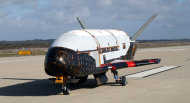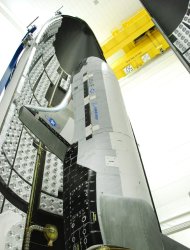Unmanned Air Force space plane lands in Calif

LOS ANGELES (AP)
— An unmanned Air Force
space plane steered itself to a landing early Saturday at a California military base, capping a 15-month
clandestine mission.
The spacecraft,
which was launched from Cape
Canaveral Air Force Station in Florida in March 2011, conducted in-orbit
experiments during the mission, officials said. It was the second such
autonomous landing at the Vandenberg
Air Force Base, 130 miles northwest of Los Angeles. In 2010, an identical unmanned spacecraft
returned to Earth after seven months and 91 million miles in orbit.
The latest
homecoming was set in motion when the stubby-winged robotic X-37B fired its
engine to slip out of orbit, then pierced through the atmosphere and glided
down the runway like an airplane.
"With the
retirement of the Space Shuttle fleet, the X-37B OTV program brings a singular
capability to space
technology development," said Lt. Col. Tom McIntyre, the
X-37B's program manager. "The return capability allows the Air Force to test new
technologies without the same risk commitment faced by other programs. We're
proud of the entire team's successful efforts to bring this mission to an
outstanding conclusion."
With the second
X-37B on the ground, the Air Force planned to launch the first one again in the
fall. An exact date has not been set.
The twin X-37B
vehicles are part of a military program testing robotically controlled reusable
spacecraft technologies. Though the Air Force has emphasized the goal is to
test the space plane
itself, there's a classified payload on board — a detail that has led to much
speculation about the mission's ultimate purpose.
Some amateur
trackers think the craft carried an experimental spy satellite sensor judging
by its low orbit and inclination, suggesting reconnaissance or intelligence
gathering rather than communications.
Harvard
astrophysicist Jonathan McDowell, who runs Jonathan's Space Report, which
tracks the world's space launches and satellites, said it's possible it was
testing some form of new imaging.
The latest X-37B
was boosted into orbit atop an Atlas 5 rocket. It was designed to stay aloft
for nine months, but the Air Force wanted to test its endurance. After
determining the space plane was performing well, the military decided in
December to extend the mission.
Little has been
said publicly about the second X-37B flight and operations. At a budget hearing
before the Senate Armed Services subcommittee in March, William Shelton, head
of the Air Force Space Command, made a passing mention.
That the second
X-37B has stayed longer in space than the first shows "the flexibility of
this unique system," he told lawmakers.
Defense analysts
are divided over its usefulness.
Joan
Johnson-Freese, professor of national security affairs at the Naval War College, said such a craft could give the U.S.
"eyes" over conflict regions faster than a satellite.
"Having a
vehicle with a broad range of capabilities that can get into space quickly is a
very good thing," she said.
Yousaf Butt, a
nuclear physicist and scientific consultant for the Federation of American
Scientists, thinks the capabilities of the X-37B could be done more cheaply
with a disposable spacecraft.
"I believe
one of the reasons that the mission is still around is institutional
inertia," he said.
The arc of the X-37
program spans back to 1999 and has changed hands several times. Originally a
NASA project, the space agency in 2004 transferred it to the Pentagon's
research and development arm, DARPA, and then to the secretive Air Force Rapid
Capabilities Office. Hundreds of millions of dollars have been poured into
development, but the current total spent remains a secret.
Built by Boeing
Government Space Systems, a unit of the company's satellite manufacturing area,
the 11,000-pound space plane stands 9 1/2 feet tall and is just over 29 feet
long, with a wingspan of less than 15 feet. It possesses two angled tail fins
rather than a single vertical stabilizer. Once in orbit, it has solar panels
that unfurl to charge batteries for electrical power.
McDowell of the
Jonathan's Space Report sees a downside. He noted it'll be tough for the Air
Force to send up such planes on short notice if it has to rely on the Atlas V
rocket, which requires lengthy preparations.
"The
requirement to go on Atlas V is a problem; they may need to look at a new
launch vehicle that would be ready to go more quickly," he said.
___
Online:
X-37B fact sheet:
http://www.af.mil/information/factsheets/factsheet.asp?fsID=16639
Vandenberg AFB:
http://www.vandenberg.af.mil

No comments:
Post a Comment